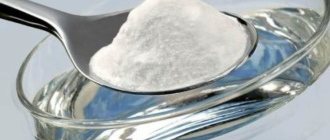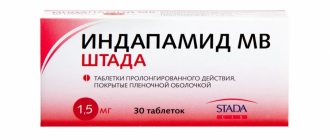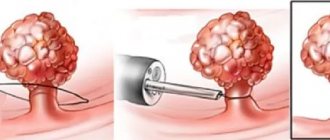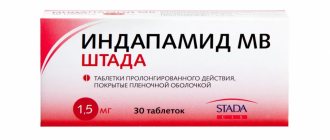Basic electrolytes
Potassium
- an important component of most cells. Together with other electrolytes, potassium ions are responsible for the functioning of muscles and nerves, normal acid-base balance, and water metabolism. The blood contains only a small amount of the macronutrient; even minor fluctuations in its level lead to serious consequences. Significant deviations from the norm can lead to life-threatening conditions (shock, cardiac dysfunction, respiratory failure, etc.). Normal potassium concentration is 3.5-5.1 mmol/liter.
Magnesium
participates in energy production, enzyme synthesis, muscle contraction and other vital processes. It is absorbed from food into the gastrointestinal tract and excreted by the kidneys. A deficiency of this electrolyte can be caused by poor nutrition, problems with its absorption, or excessive loss in urine. Elevated levels may indicate kidney pathologies. Significant electrolyte deficiency leads to symptoms such as weakness, confusion, loss of appetite, and muscle spasms. Its excess manifests itself in a similar way. Heart rhythm disturbances and nausea may also be added to the symptoms.
Sodium
present in all tissues and fluids of the body. It is necessary for muscle contraction and maintaining water-salt balance. The macroelement is absorbed in the intestines from ordinary table salt. Deviations of its normal level are associated with a violation of one of the mechanisms of its maintenance. For example, normal sodium concentrations are disrupted if antidiuretic hormone, which prevents fluid loss through urine, is produced in abnormal amounts. A violation of the amount of this electrolyte leads to the appearance of edema or dehydration, as the amount of fluid in the tissues changes. Sodium testing is used in the diagnosis of many diseases (for example, pathologies of the kidneys, lungs, brain).
Chlorine
It is part of many biologically active substances and performs a number of physiological functions. Its level is normally relatively stable (a slight decrease in levels is observed after eating). A test for the amount of chlorine is often prescribed in conjunction with other studies to identify various pathologies. Its results are also used to determine the cause of weakness, prolonged vomiting, diarrhea, and breathing problems.
Electrolytes (sodium, potassium, chlorine, calcium)
Sodium, potassium and chlorine are the body's main electrolytes.
Electrolytes are mineral compounds that are capable of conducting electrical charge. Being in tissues and blood in the form of salt solutions, they help move nutrients into cells and remove metabolic products from cells, maintain water balance and the required level of acidity in them.
Research method
Ion selective electrodes.
Units
mmol/l (millimoles per liter).
What biomaterial can be used for research?
Venous blood.
How to properly prepare for research?
- Eliminate alcohol from your diet for 24 hours before the test.
- Do not eat for 12 hours before the test.
- Do not smoke for 30 minutes before donating blood.
General information about the study
Electrolytes are mineral compounds that have an electrical charge. They are found in body tissues and in the blood in the form of salt solutions. Electrolytes contribute to the movement of nutrients into the body's cells and the removal of metabolic products from them, maintaining the water balance of cells and stabilizing acidity (pH).
The main electrolytes in the human body are sodium (Na+), potassium (K+) and chlorine (Cl-).
Most of the sodium is found in intercellular fluids. Potassium is found primarily inside cells, but small but vital amounts are found in plasma, the liquid part of the blood.
Monitoring potassium levels is very important. Even minor changes can affect the heart rate and the heart's ability to contract. Chlorides migrate through the membrane either inside or outside the cell and thereby maintain its electrical neutrality. Chloride levels usually correspond to sodium levels.
Sodium, potassium and chlorides enter the body with food, while the kidneys are involved in removing them from the body. The balance of these chemical elements is an important indicator of human health, particularly how the kidneys and heart function.
Measuring the levels of sodium, potassium and chloride together allows you to determine the anion “window” - the difference in the content of anions and cations in the blood. Its abnormal value is not a specific indicator, but suggests the presence of toxic substances in the body or the likelihood of metabolic abnormalities caused by fasting or diabetes.
Ionized calcium is a cation that circulates freely in the blood and makes up 46-50% of all blood calcium. Its level increases when blood pH decreases and decreases when alkalization occurs. For every 0.1 unit decrease in pH, ionized calcium responds with an increase of 1.5-2.5%.
Because electrolyte and acid-base imbalances are associated with a wide range of acute and chronic diseases, electrolyte testing can be ordered for both hospitalized patients and those newly presenting to emergency departments.
What is the research used for?
- For electrolyte screening and acid-base imbalance testing.
- To monitor the effectiveness of treatment for imbalances affecting the functioning of certain organs.
- The total blood calcium level is often sufficient for a preliminary assessment of calcium metabolism. It usually reflects the amount of free calcium in the blood, since often the balance between bound and free calcium is a stable and fairly predictable value. However, in some people this ratio is disrupted, so the level of total calcium is not a criterion for assessing overall calcium metabolism. In such cases, checking the ionized calcium becomes necessary.
What do the results mean?
Reference values
| Electrolyte | Reference values |
| Potassium | 3.5 - 5.1 mmol/l |
| Sodium | 136 - 146 mmol/l |
| Chlorine | 98 – 106 mmol/l |
| Calcium | 1.16 - 1.32 mmol/l |
Levels of potassium, sodium and chlorine depend on their dietary intake, body water content and the amount of electrolytes excreted by the kidneys. In addition, it is influenced by natriuretic proteins, which promote the excretion of sodium by the kidneys, as well as the hormone aldosterone, which maintains sodium concentration at a constant level and increases the body's loss of potassium.
Among all electrolytes, the most important indicators for a person are potassium and sodium levels. When kidney function is impaired, the body can sometimes retain excess fluid to dilute sodium and chloride so that its concentration drops below normal.
With severe fluid loss, the concentration of potassium, sodium and chlorides can increase sharply. Some forms of heart disease, muscle problems, nervous system problems, and diabetes also cause abnormal levels of one or more electrolytes.
To determine the cause of electrolyte disturbance and prescribe the correct treatment, it is important to find out which electrolyte balance is disturbed. If such abnormalities are not treated, the patient faces dizziness, seizures, irregular heartbeat and even death.
Reasons for increasing the level of ionized calcium:
- acidosis,
- excess vitamin D,
- malignant neoplasms,
- primary hyperparathyroidism,
- benign parathyroid adenomas,
- metastatic bone lesions.
- alkalosis,
- magnesium deficiency,
- pancreatitis,
- postoperative period,
- sepsis,
- injury,
- lack of vitamin D.
- Reasons for decreased ionized calcium levels:
Potassium in the blood
In clinical biochemistry, K metabolism is assessed based on its content in the blood plasma (intravascular pool), although it contains no more than 2% of the total amount of the cation. The overwhelming majority of K in the body is located inside cells, and its concentration in plasma, which only approximately reflects the total content of the element in the body, can fluctuate within significant limits, especially in severe pathologies. It is closely related to the state of blood circulation and acid-base balance, therefore the determination of K in plasma or serum is one of the most important indicators during the period of resuscitation.
Disturbances in blood pH have a significant effect on the level of K in the blood plasma. Metabolic acidosis causes the movement of hydrogen ions into the cell in exchange for intracellular K, which leads to a decrease in potassium content in tissues. With alkalosis, on the contrary, an increase in the K content in tissues is observed. The level of K in plasma is affected by the content of the HCO3 - anion in the blood, which reflects the activity of catabolic processes.
A decrease in the concentration of potassium in the blood occurs when there is insufficient intake of potassium from food, increased loss by the kidneys (taking diuretics, the diuretic stage of acute renal failure, tubular acidosis, increased secretion of ADH, excess mineralocorticoids, etc.); increased losses due to vomiting or diarrhea, intravenous administration of large volumes of fluid that does not contain K, redistribution of K between extra- and intracellular fluid (acute and chronic metabolic acidosis, acute respiratory alkalosis, administration of insulin or glucose). The most common cause of hypokalemia is increased loss of K by the kidneys; insufficient K intake rarely causes hypokalemia.
Hypokalemia can occur in alcoholics even with a slight increase in Na levels in the blood. Drinking large quantities of beer also leads to hypokalemia and hyponatremia; Beer contains very few salts.
Hyperkalemia can develop in cases of increased K intake (reception of excess K during diuretic therapy, parenteral administration, blood transfusion with expired shelf life), redistribution of K between water spaces (tissue damage, activation of catabolic processes, systemic acidosis), decreased K+ excretion (acute and chronic renal failure, long-term use of potassium-sparing diuretics, mineralcorticoid deficiency).
Hyperkalemia in adrenal insufficiency is accompanied by low levels of Na in the blood plasma, hypokaliuria, and high renin activity. Hyperkalemia with selective aldosterone deficiency is accompanied by low renin levels and impaired cortisol levels in the blood. Disorders of carbohydrate metabolism in acute and chronic renal failure provoke hyperkalemia and metabolic alkalosis.
A common cause of elevated K levels in blood plasma is non-compliance with blood collection conditions. The most common mistake is hemolysis. With a large number of platelets or leukocytes, as occurs in cases of myeloproliferative diseases, pseudohyperkalemia may occur due to increased release of potassium from the cells.
Indications for the study
- Diseases of the cardiovascular system (arrhythmias, arterial hypertension);
- kidney pathology;
- adrenal insufficiency;
- control of therapy with diuretics, cardiac glycosides;
- carrying out hemodialysis.
Features of sample collection and storage:
blood serum without signs of hemolysis. Blood is taken with minimal compression of the vein without muscle load. Samples are stable for no more than 3 hours at room temperature.
Research method:
Determination of the concentration of potassium ions in the blood is currently carried out mainly by the ion-selective method.
Reference interval:
3.5 – 5.1 mmol/l
Increased values
- Hypoaldesteronism primary and secondary;
- acute renal failure;
- taking ACE inhibitors; potassium-sparing diuretics;
- diabetic ketoacidosis;
- increased breakdown of cells and tissues (intravascular hemolysis, rhabdomyolysis, prolonged fasting, convulsions, severe injuries, deep burns, destruction of tumor cells);
- dehydration.
Reduced values
- Primary and secondary hyperaldosteronism;
- hypercortisolism;
- renal dysfunction;
- increased loss of potassium through the gastrointestinal tract;
- hyperglycemia;
- hypothermia;
- lack of potassium in the body (chronic starvation, anorexia).
How to lower potassium levels
If the amount of microelement is not controlled, the risk of a heart attack will increase. The first step in dealing with hyperkalemia should be to see a doctor. The specialist must check all medications and dietary supplements that the patient takes and find analogues to drugs that provoke an increase in potassium levels.
If total potassium is slightly increased, the problem can be dealt with without the help of a doctor. It is enough to refuse products with a high content of microelements in their composition. In particular, it is better to replace cow's milk with a natural oat or rice drink. Tomatoes and oranges are other common foods that increase potassium levels in the blood. As an alternative, nutritionists suggest eating grapes, apples or cranberries. You can also use less table salt.
You can get tested quickly and painlessly in our clinic. The technician will take a small amount of blood from a vein. The whole procedure will not take even ten minutes.
Important! During blood sampling for total potassium, it is strictly forbidden to clench your fist. This can lead to pseudohyperkalemia: the release of electrolyte outside the cells, the formation of a blood clot in a test tube. As a result, the analysis results will artificially increase by 1.5-2 mmol/l. At a rate of 3.5 – 5.0 mmol/l, such a “deviation” can be critical.
If your total potassium test results are outside the normal range, it does not necessarily indicate a medical condition that requires immediate medical attention. Some dietary supplements, multivitamins, and even herbs can increase potassium levels in the blood. The clinic specialists will definitely issue a sheet with the results of the analysis. But the indicators must be deciphered by a specialized doctor.
When is a total potassium test prescribed?
Your doctor may order a total potassium blood test for those diagnosed with heart or kidney disease. An indication for a blood test may be suspected hyperkalemia. The following symptoms should alert you:
- irregular heart rhythm;
- unexplained fatigue;
- muscle weakness;
- nausea;
- trembling, tingling in the arms and legs.
Hyperkalemia (high potassium in the blood) most often occurs as a result of kidney dysfunction.






